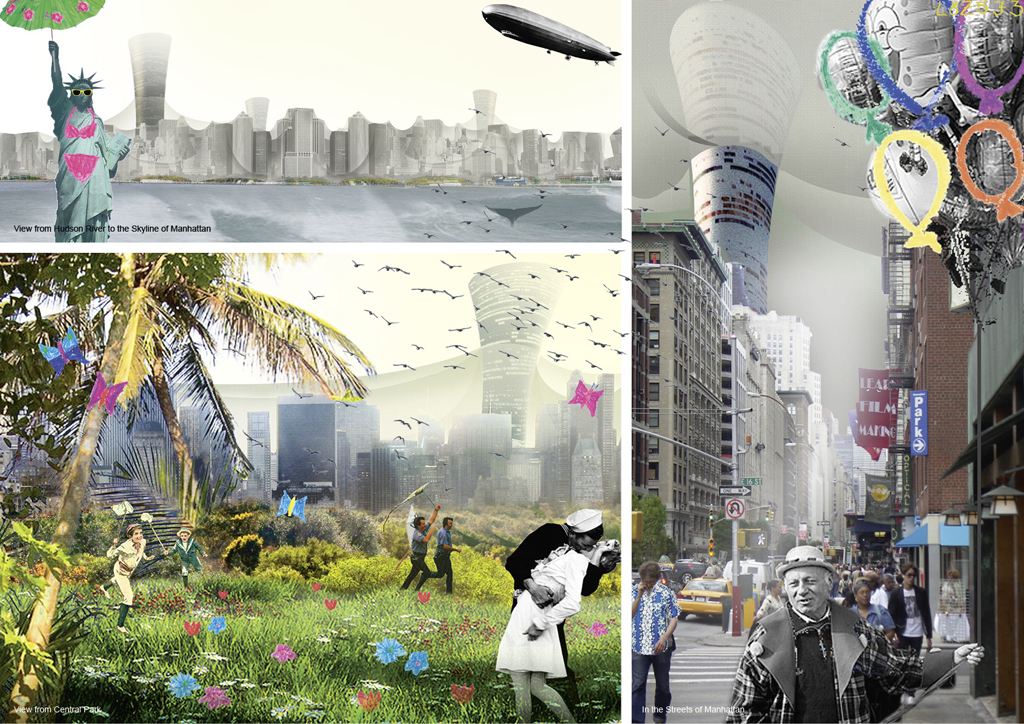Info:
Title: Manhattan Ography - Code: L9M3C7Contest: NY / 2012
By: R. Wang
Views: 2519 Likes: 0
Votes:
JOSHUA PRINCE-RAMUS0 EVA FRANCH I GILABERT2 ROLAND SNOOKS1 SHOHEI SHIGEMATSU1 ALESSANDRO ORSINI3 MITCHELL JOACHIM21.5
Manhattan Ography

 The aim of the proposal is a simple one: How can an architectural culture which focuses on serving the 1% (of income earners inAmerica) be coerced to benefit the 99%? The result is part pamphlet manifesto and part public infrastructure. By enabling the public to action by means of infrastructural possibilities (the creation of these hybrid cranes, bridges, & watch-towers), one can begin to combat against the monumentality and utter remoteness of much ofNew York’s corporate architecture. The boards present a future where all ofNew Yorkhas been foreclosed, leaving much of its valuable real estate inaccessible. The existence of these hybrid structures at nodes around the city allows for a different type of agency forNew York’s remaining inhabitants – vertical mobility. Thus the monuments to the wealthy are re-appropriated by these series of crane structures and can become the new terrain of theNew City. These cranes are outposts, sentry stations, watchtowers, and construction cranes, able to lift the inhabitants of a post-foreclosedManhattanup into the sky. The valleys and canyons of the skyscrapers are now truly valleys and canyons – to be traversed and conquered. Water towers quench the thirsty and communities begin to take back from above what was barred to them from below.
The aim of the proposal is a simple one: How can an architectural culture which focuses on serving the 1% (of income earners inAmerica) be coerced to benefit the 99%? The result is part pamphlet manifesto and part public infrastructure. By enabling the public to action by means of infrastructural possibilities (the creation of these hybrid cranes, bridges, & watch-towers), one can begin to combat against the monumentality and utter remoteness of much ofNew York’s corporate architecture. The boards present a future where all ofNew Yorkhas been foreclosed, leaving much of its valuable real estate inaccessible. The existence of these hybrid structures at nodes around the city allows for a different type of agency forNew York’s remaining inhabitants – vertical mobility. Thus the monuments to the wealthy are re-appropriated by these series of crane structures and can become the new terrain of theNew City. These cranes are outposts, sentry stations, watchtowers, and construction cranes, able to lift the inhabitants of a post-foreclosedManhattanup into the sky. The valleys and canyons of the skyscrapers are now truly valleys and canyons – to be traversed and conquered. Water towers quench the thirsty and communities begin to take back from above what was barred to them from below.
The towers of the 1% no longer act as vacant monuments to past wealth. They now become the basis for theNew City. They are resource havens to be harvested for their potential energy and building materials. They are the fossils of the past, existing now only to fuel a new civic energy devoid of capital and privilege.
Thus we can find comfort that our architecture built for private enterprise to tower over the public, can be at the very least, stepped on with no guilt whatsoever.
*footnotes
The panels feature drawings, images, & books covers covering this tumultuous period in New Yorkarchitecture. Manhattanography, or the study of the island, exists as a rough collaged document attempting to represent the scattered, unplanned, but revolutionary ideas latent in the designs of the period. No digital architectural drawings have been yet discovered.






